
Image posted by Jeff Manber on Twitter (@jeffmanber), Managing Director at NanoRacks, our SSEP Strategic Partner, showing 2 small satellites being launched from ISS on February 12, 2014, using the new NanoRacks satellite deployer CLICK TO ZOOM
There are two payloads of student flight experiments currently being conducted aboard the International Space Station (ISS) by astronaut Koichi Wakata (Japan) – the Falcon II payload of 12 SSEP Mission 3b experiments and the Orion payload of 11 SSEP Mission 4 experiments. With this post on the SSEP National Blog, we are honoring the 11 student flight teams for the Mission 4 Orion payload of experiments. A February 11, 2014, blog post was dedicated to the 12 student flight teams for the Falcon II payload of Mission 3b experiments. (FYI – you can watch Koichi activating some of the Mission 3b and Mission 4 experiments.)
The student researchers comprising the 11 flight teams for SSEP Mission 4 to ISS are remarkable Ambassadors for America’s next generation of scientists and engineers, and represent the 3,080 students that were engaged in Mission 4 experiment design across the 11 participating communities, and the 744 flight experiment proposals received from student teams. Through a formal proposal review and selection process mirroring how professional research proposals are reviewed, 11 experiments were selected – one for each community. Read about the Mission 4 review and selection process, and meet the Mission 4 to ISS Step 2 Review Board which convened on May 21, 2013, at the Smithsonian National Air and Space Museum.
We are now just 13 days from the next Crew Interaction Day (the 4th of 6) with the SSEP experiments on ISS, on February 26, 2014. We are just 27 days from the expected de-orbit and return to Earth of the two payloads on March 12, 2014, aboard Soyuz 36S. In other SSEP news, the 15 selected Mission 5 flight experiment teams are now refining and optimizing their experiments, which are currently undergoing formal Flight Safety Review at the Toxicology Office at Johnson Space Center in Houston. The Mission 5 experiments are set to launch to ISS as the Charlie Brown payload aboard Orb-2 out of the Mid-Atlantic Regional Spaceport (MARS) in spring/summer 2014. We are just 11 days away from the start of program operations for SSEP Mission 6 to ISS on February 24, 2014. And at the end of this month, the National Center for Earth and Space Science Education, and the Arthur C. Clarke Institute for Space Education, are set to announce, to 115,000 school district superintendents and principals across the U.S. and Canada, Mission 7 to ISS (the 9th SSEP flight opportunity in 3.5 years), with program operations starting September 2014. So stay tuned to this space for breaking news on the Student Spaceflight Experiments Program, and pass on to friends and colleagues that they can subscribe to this Blog at the bottom of the right column.
The National Center for Earth and Space Science Education, the Clarke Institute for Space Education, and NanoRacks, are now honored to present the Mission 4 experiments below. For each community below, the link to the ‘Community Profile’ will allow you to read about the community’s strategic needs in STEM education, how SSEP is helping to address those needs, and all the organizational Local Partners that made the community’s participation in SSEP possible.
We have also included videoclips recorded and archived by the Smithsonian National Air and Space Museum of Mission 4 teams that presented on their experiment design (before launch to ISS) at the 3rd SSEP National Conference, held at the Museum in Washington, DC, July 2-3, 2013. We thought we would start with future Drs. Azuara and Chavez, the Mission 4 student flight team from Pharr, Texas, who were in 5th grade at the time of the conference, and the youngest presenters. These young researchers identified a biological system to study. They crafted a real microgravity experiment that needed to be constrained by the operation of a real research mini-laboratory, and flight operations to and from low Earth orbit. Through formal submission of an experiment proposal, they competed against 67 other proposing teams in their community – and were selected. They presented their experiment design and rationale at a real research conference at the Smithsonian. And they are now microgravity researchers with an experiment aboard the International Space Station overseen by an astronaut. Brianna and Amanda, you have both done something truly remarkable, and give us all pause – because you shine a bright light on what our children can achieve if we just give them a chance, provide the needed guidance, and know when to get out of the way. (Isn’t this a recipe for all our classrooms?) And you should know that the majority of professional researchers likely did not present at their first research conference until graduate school, in grade 19 and beyond.
To all the Mission 3b and Mission 4 student researchers, we are collectively – your teachers, your families, your communities, your nation – very proud of you.
1. Highlands Ranch, Colorado
Jump to Highlands Ranch’s Community Profile
SELECTED FOR FLIGHT:
What Are the Effects of Creation of Beer in Microgravity and is it Possible?
Grade 6, STEM School and Academy, Douglas County School District
Principal Investigator: Michal Bodzianowski
Teacher Facilitator: Sharon Combs, Physical Science Teacher
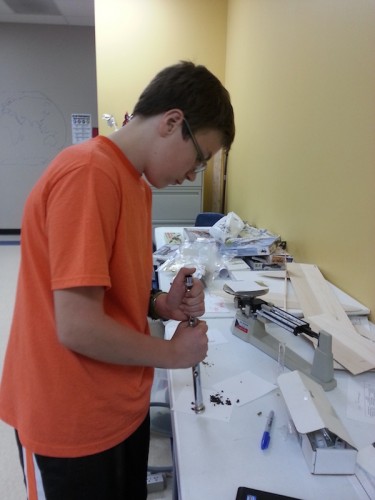
Microgravity researcher Michal Bodzianowski assessing his experiment in the Fluids Mixing Enclosure (FME) mini-lab. Click for Zoom
Proposal Summary:
By combining the four main ingredients (malt barley, hops, yeast, and water) of beer in space, will we be able to produce alcohol? This question was inspired by the use of beer as a replacement to regular water, as the alcohol killed bacteria that were in regular water. If an emergency occurred, and all water was polluted, creating beer from it will disinfect it, and it is relatively cheaper than purifying it with special tablets that may not last. And as it kills bacteria, it can also be used medically to disinfect wounds. The experiment’s results will be useful for both medical and survival reasons, and it is fairly easy to conduct with limited human interactions. Experiment will be measured by hydrometer tests to see if any alcohol was produced by the yeast-sugar reaction. References: (Hanson, 1997-2013)
2. Indiana State Science Education Consortium (INSEC), Indiana
Jump to INSEC’s Community Profile
SELECTED FOR FLIGHT:
The Effect of Microgravity on the Development of the Salamander
Grade 6 & 8, Avicenna Academy in Crown Point, IN
Co-Principal Investigators: Ameer Rifai and Jenna Rifai
Teacher Facilitator: Mrs. Nicole Gustafson, Teacher
Proposal Summary:
This experiment will be testing the effect of microgravity on the development of the Salamander. I wanted to do this experiment because people have done a similar experiment testing frogs in microgravity and different developments have happened. I would like to see if I can find similar or new differences regarding development in gravity with an amphibious organism. Gravity plays an important role in the development process. I am curious to see if and how microgravity will effect this development. Gaining knowledge on this experiment, may lead to further exploration of other living organisms’ development, such as humans, in microgravity. For this experiment, I will be sending ten fertilized salamander eggs to the ISS where they will begin to grow and develop. Before the salamanders leave the ISS, formaldehyde will be mixed with the salamanders to stop the growth. When they return to Earth, I will observe them for any abnormalities and compare them to the salamanders on Earth.
3. Huron County, Michigan
Jump to Huron County’s Community Profile
SELECTED FOR FLIGHT:
The Effect of Microgravity on Calcium Absorption by Bones
Grade 7, Elkton Pigeon Bay-Port Laker Junior High School, Elkton Pigeon Bay-Port Schools
Co-Principal Investigators: Chandler Furness, Sarah Hammond, Chelsey Katshor, and Halle Keim
Collaborators: Hannah Hammond and Nicholas Wolschlager
Teacher Facilitator: Ms. Diana Schulz, 7th & 8th Grade Science Teacher
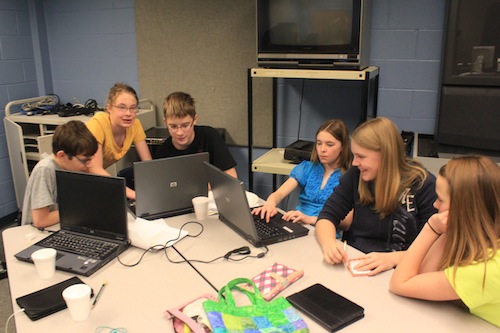
Left to right: Chandler Furness, Sarah Hammond, Nick Wolschlager, Hannah Hammond, Chelsey Katshor, and Halle Keim. The team is working on a rough draft of their proposal. Click for Zoom
Proposal Summary:
We are attempting to find out if a decalcified bone absorbs calcium in microgravity. We hypothesize that the decalcified bone will absorb the calcium from the calcium solution to sustain calcium levels in microgravity. On Earth, we predict the bone’s density will increase. We will be using a decalcified bone since harvested bone cells die without homeostasis. (Bones in Space 2009). We will x-ray, measure, and weigh the bone to determine its density/mass: 1) before it is decalcified, 2) after decalcification and, 3) after the SSEP flight. We will test our experiment on Earth by combining crushed calcium pills, buffered saline and a section of the wishbone (furcula) of a chicken (Gallus domesticus).
We used chicken bone because it fits in the nanorack tube yet the pieces from the same bone are available for testing our experiment on Earth and in microgravity. This way, we can use the other half to fulfill the requirements in space. If we used a different bone, our results may differ and would be hard to compare. We chose this topic because “when astronauts are in space they lose 14% of their bone density and scientists have yet to find a way to sustain bone density…” (Malik 2009). If we could find a way to help sustain bone density, we could help astronauts’ health. This would also allow them to continue being in space without the problem of loss of bone density, which would reduce the risk of broken bones while in space and osteoporosis.
4. Warren, Michigan
Jump to Warren’s Community Profile
SELECTED FOR FLIGHT:
The Formation of Silver Crystals in Microgravity
Grade 11, Macomb Mathematics Science Technology Center, Warren Consolidated Schools
Co-Principal Investigators: Steven Prascius and Sydney Waynick
Co-Investigator: Hunter Montrose
Teacher Facilitator: Mrs. Rosemarie Cybulski, Interdisciplinary Studies Teacher
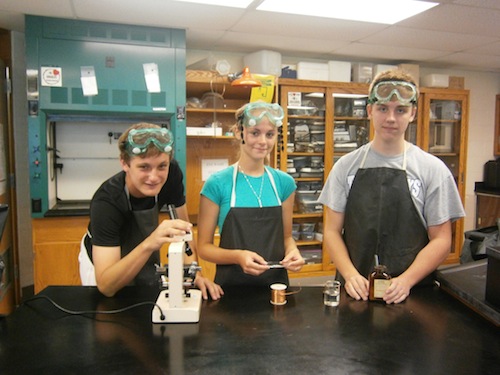
Co-PIs Steven Prascius and Sydney Waynick, and Co-I Hunter Montrose will explore crystal growth in space. Click for Zoom
Proposal Summary:
What happens to the formation of crystals in an environment with both increased radiation and microgravity? The experiment we are proposing is to test if crystals can be formed in space and if they are similar to those formed on Earth. We are testing this because crystal has been found to be able to store natural gas due to their porous and rigid nature (Porous Crystals For Natural Gas Storage). We predict these crystals to form in space as they do on earth because the actual formation of the crystals is caused by a chemical reaction that does not seem to depend on gravity for the formation of the crystals. If our hypothesis is correct and these crystals that are grown in space have the same properties as those on earth, they may show that crystals could have use in storing fuel in space. In this experiment, the crystals will be compared on their color, average size, symmetry, approximately how many faces they have, and any other structural difference between samples. Also, the masses of each sample will be measured to compare any differences in the sizes of the samples. By comparing the two samples of crystals in these categories, it will be evident if the space crystals are physically the same as those formed on earth.
5. Children First Network 201, New York City, New York
Jump to the CFN201 Community Profile
SELECTED FOR FLIGHT:
Effect of Microgravity in Structure of the Fungus Flammulina populicola
Grade 10, The Bronx High School of Science, District 10
Co-Principal Investigators: Wei Li, Alvin Wong, and Patrick Yang
Teacher Facilitator: Dr. Robert Muratore, Physical Science Teacher
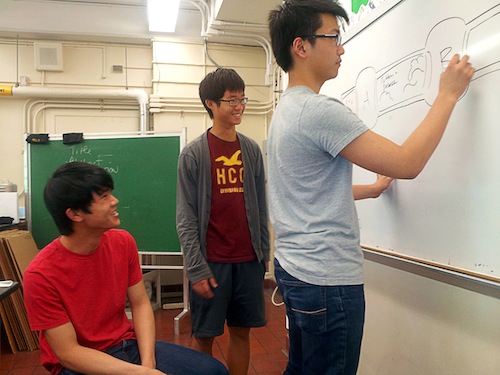
Co-PIs Alvin Wong, Patrick Yang, and Wei Li of the Bronx High School of Science plan their ISS experiment. Click for Zoom
Proposal Summary:
There are four fundamental forces that influence the entire universe, the most adverse and mysterious being gravitation. Gravity is a nearly constant force on the surface of the Earth; fractional levels can be obtained in orbital environments. As it is prevalent in our lives it is difficult to imagine the effect of microgravity on basic things although they play important roles in the development of certain objects. In this experiment we test the effect of microgravity on the fungus Flammulina populicola, classified as Basidiomycota or gill fungus (mushroom). It is previously known that gravity already has a profound effect on the growth and structural development of F. velutipes. Fungal growth from spores and growth medium (aqueous sucrose solution) in a Type 3 Fluids Mixing Enclosure in the International Space Station will be compared to fungal growth in matching enclosures on Earth. After several days the fungus will be preserved. Upon the return to Earth, the structure and growth will be compared to a control group that has been growing under the influence of Earth’s gravity. The comparison will be made by observing any evident changes and inspecting the cross-section of each sample under a light microscope.
6. Rochester, New York
Jump to Rochester’s Community Profile
SELECTED FOR FLIGHT:
Dehydrated and Live Tardigrades Vs. Microgravity
Grade 11, Rochester Early College International High School, Rochester City School District
Co-Principal Investigators: Cheyanne Jeffrey and Jo’ce Hill
Co-Investigator: Cierra Cannon
Collaborator: Vicki-Ann Aman
Teacher Facilitator: Ms. Mary Courtney, Science Teacher
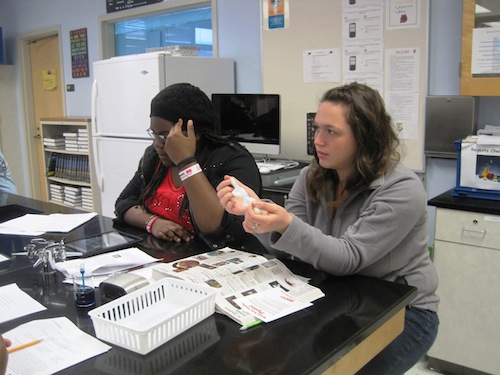
Co-PI Cheyanne Jeffrey and Collaborator Vicki-Ann Aman discuss contents of the FME during a team planning meeting. Click for Zoom
Proposal Summary:
This proposal focuses on two experiments. The first is the see whether rehydrated tardigrades in a microgravity environment have any structural and behavioral differences from the dehydrated tardigrades on Earth. The second experiment will be the same except with live tardigrades. Tardigrades are known for their ability to withstand any type of conditions. What we want to test is while dehydrated and activated in space, can they still survive or will they behave differently. The same experiment will be done on Earth. After the six weeks in microgravity, the experiment will return to Earth and we will examine them microscopically. We will then compare the two experiments and see any difference between the two. We will look for any structural and behavioral differences.
7. Downingtown, Pennsylvania
Jump to Downingtown’s Community Profile
SELECTED FOR FLIGHT:
Aleve XR and Microencapsulation in Microgravity
Grade 9, Downingtown S.T.E.M. Academy, Downingtown Area School District
Co-Principal Investigators: Miranda Mc Millen and Christina Murray
Co-Investigators: Jenni Faust and Meghan Joyce
Collaborators: Avni Gulrajani, Connor McGrath, Cecilia Padilla, and Santina Zouras
Teacher Facilitator: Mr. Eric Daney, Physics Teacher
Proposal Summary:
The focus of this experiment is to observe how microgravity affects the release of the microencapsulated drug Aleve XR. From the outcomes of previous experiments done in space that are similar to ours, we have come to the prediction that the release rate of the drug will be prolonged. The experiment requires that the microcapsule be dissolved by a simulated stomach acid made up of hydrochloric acid, deionized water, sodium chloride, and potassium chloride. When the experiment is sent back to earth, the concentration of amphetamines released by the Aleve XR will be compared to the concentration of the amphetamines released on earth, in order to see how microgravity affects how strong the microencapsulation of the drug is. If there is a lower concentration of Aleve XR, then this means that the microcapsule is stronger in space, because the coating would have lasted longer. The results of this experiment will also provide researchers with information regarding the effects of microgravity, specifically on the release of microcapsules. Astronauts can then act accordingly on how heavy each dose needs to be in order to be effective on a particular disease. It can also contribute to manufacturing longer lasting medicines, if the microcapsule stays intact in microgravity.
8. Jamestown, Pennsylvania
Jump to Jamestown’s Community Profile
SELECTED FOR FLIGHT:
Bacteria and Decomposition
Grade 9-10, Jamestown High School, Jamestown Area School District
Principal Investigator: Jason Liszka
Co-Investigators: April Minto, Cade Lamont, Sydney Holler, and Trey Saulsbery
Co-Teacher Facilitators: Chalsie Kennedy, Spanish Teacher and Harry Rohrbacher, Biology Teacher
Proposal Summary:
Our project will take a closer look at a bacteria’s ability to decompose soil in space. In order to have human beings live safely in outer space for extended periods of time, it is important to look at one of Earth’s decomposer’s ability to function in microgravity. If life is going to be sustained in space, it is important to see if a decomposer is capable of breaking down waste and adding nutrients to the soil.
9. North Charleston, South Carolina
Jump to North Charleston’s Community Profile
SELECTED FOR FLIGHT:
The Effect of Microgravity on the Oxidation of Metal Exposed to a Salt Water Solution
Grade 7, Palmetto Scholars Academy, South Carolina Charter School District
Co-Principal Investigators: Griffin Eslinger and Alexander Puckhaber
Teacher Facilitator: Mrs. Kellye Voigt, Science Teacher
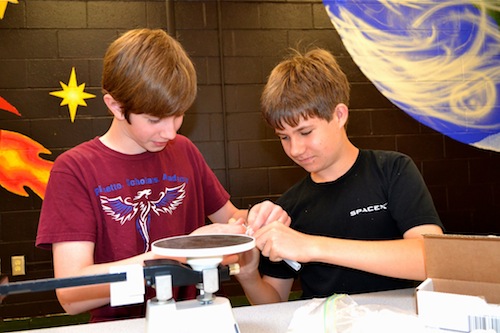
Future Drs. Griffin Eslinger and Alex Puckhaber assessing pH of saltwater solution before introduction into the FME mini-lab. Click for Zoom
Proposal Summary:
We want to examine the structural integrity of iron exposed to a saltwater solution in microgravity. We think that the oxidation will change because the surface tension of the liquid in space is more apparent than in normal gravity. We chose iron for our experiment because it rusts quickly and will be easier to examine during a limited time frame of the experiment.
We will use a type 2 fluid mixture enclosure (FME) with salt water on one side and an iron bar and oxygen in the other. The iron bar will be the kind used for metal tensile testing; the oxygen and salt water will oxidize it. The two will mix when the astronaut releases the clamp and shakes the container. We will have three test samples, one with salt water in space, one with salt water on Earth, and one with no salt water on Earth. Once we get the product of the three experiments, the two on Earth and the one in microgravity, we will test them. We will use a metal tensile test to measure the integrity of the iron bars, and a scanning electron microscope to look for differences in corrosion.
Knowing how liquids in microgravity affect the oxidation of metals is important when designing containers for the International Space Station and manned spacecrafts. This will also be useful in understanding oxidation in low gravity environments like on the moon or Mars.
10. Hays County, Texas
Jump to Hays County’s Community Profile
SELECTED FOR FLIGHT:
L. acidophilus Bacteria Growth in Microgravity
Grade 5, Ralph Pfluger Elementary School, Hays CISD
Principal Investigator: Emily Vladyka
Co-Investigators: Avery Bentz, Caden Stewart, and Emma Hodges
Teacher Facilitator: Lavada Ferguson, 5th Grade Teacher
Proposal Summary:
We are testing L. acidophilus bacteria growth in microgravity. A L. acidophilus bacterium is a probiotic bacterium that is important for bone strength and intestinal health in humans. People get probiotic bacteria from yogurt and other dairy products. The body produces these bacteria in the intestinal tract, but the amount produced is not enough to keep you healthy.
If humans eventually colonize space or another planet, we will need ways to stay healthy. A Probiotic bacterium is one way to keep the body strong and healthy. Because of the importance of these bacteria to the human body, we wonder if microgravity has any effect on its growth.
11. Pharr, Texas
Jump to Pharr’s Community Profile
SELECTED FOR FLIGHT:
How does microgravity effect the growth of mold on bread?
Grade 5, Cesar Chavez Elementary, PSJA ISD
Co-Principal Investigators: Brianna Azuara and Amanda Chavez
Teacher Facilitator: Celena Miller, Science Teacher
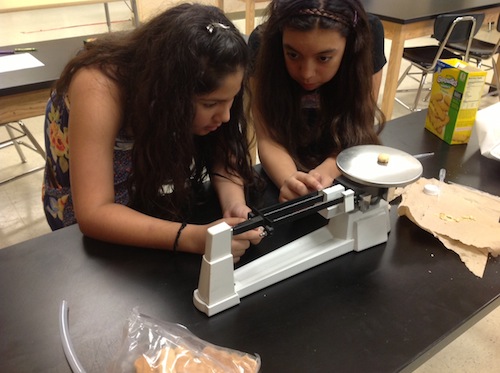
Future scientists Brianna Azuara and Amanda Chavez measure the mass of their samples during the experiment design phase. Click for Zoom
Proposal Summary:
How does microgravity affect the mold growth on bread? We are hoping to learn from our question. We want to know how mold on bread reacts differently on Earth than in microgravity, and will use “Gerber Graduates for Toddlers Lil’ Biscuits”.
The procedures for conducting our experiment in microgravity are as follow. First, the biscuit will arrive packaged and refrigerated to Houston. Then, put the biscuit (2 grams) inside the Nanoracks minilab, which will be separated by a clamp. Finally, on A+2 the astronauts will slowly open the clamp letting two milliliters Aquafina distilled water drop, giving the biscuit moisture to start growing mold.
Once returned to Earth we will take observations by observing the biscuit’s color, texture, thickness of mold, and also by viewing the slide of the mold spores under the microscope. We are also going to do an exact replica of the experiment on Earth at the same time as the experiment conducted in microgravity, so we could compare both experiments.
After this project, I will want to learn and discover how mold will react on other planets. It will be interesting to compare mold growth on different parts on space, on microgravity and in our planet Earth. By getting our answer to our question it will improve people’s current understanding of mold and how it reacts both on Earth and in microgravity. This experiment can solve all unknown questions that lots of people have waited to be answered. This is the future of all science questions!
The Student Spaceflight Experiments Program (SSEP) is a program of the National Center for Earth and Space Science Education (NCESSE) in the U.S., and the Arthur C. Clarke Institute for Space Education internationally. It is enabled through a strategic partnership with NanoRacks LLC, working with NASA under a Space Act Agreement as part of the utilization of the International Space Station as a National Laboratory. SSEP is the first pre-college STEM education program that is both a U.S. national initiative and implemented as an on-orbit commercial space venture.
The Smithsonian National Air and Space Museum, Center for the Advancement of Science in Space (CASIS), and Subaru of America, Inc. are National Partners on the Student Spaceflight Experiments Program.

Comments are closed.